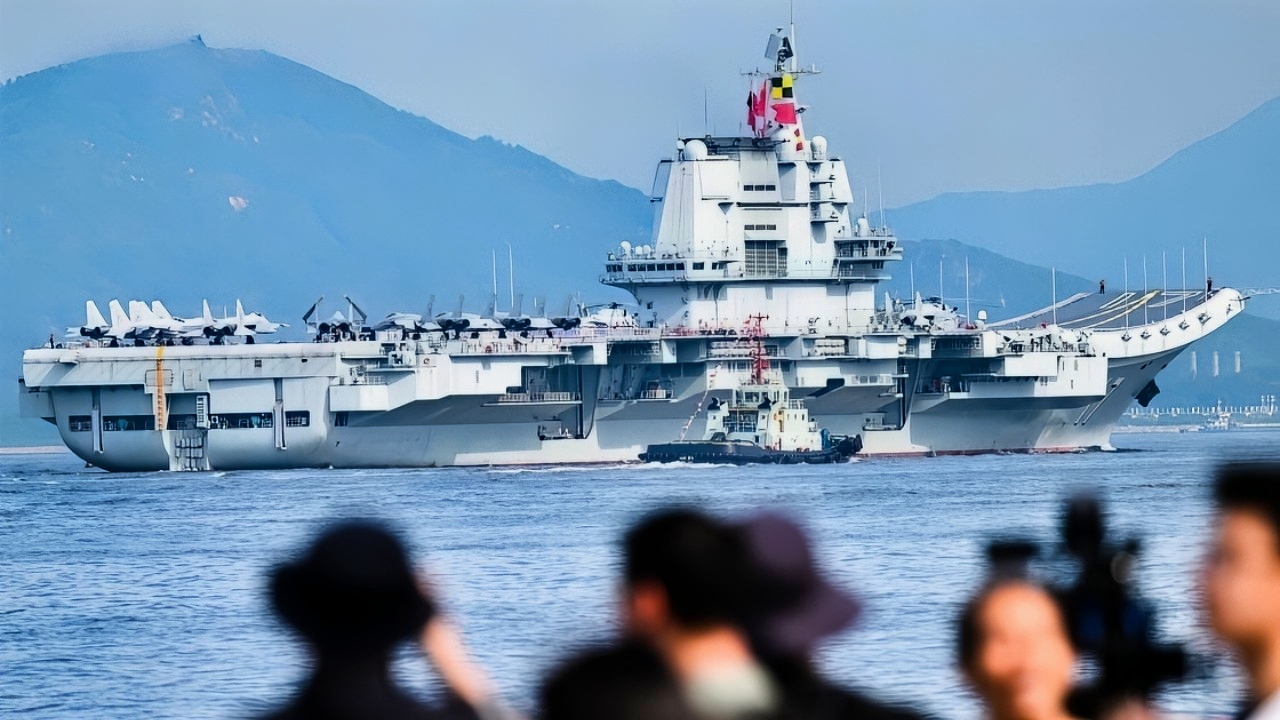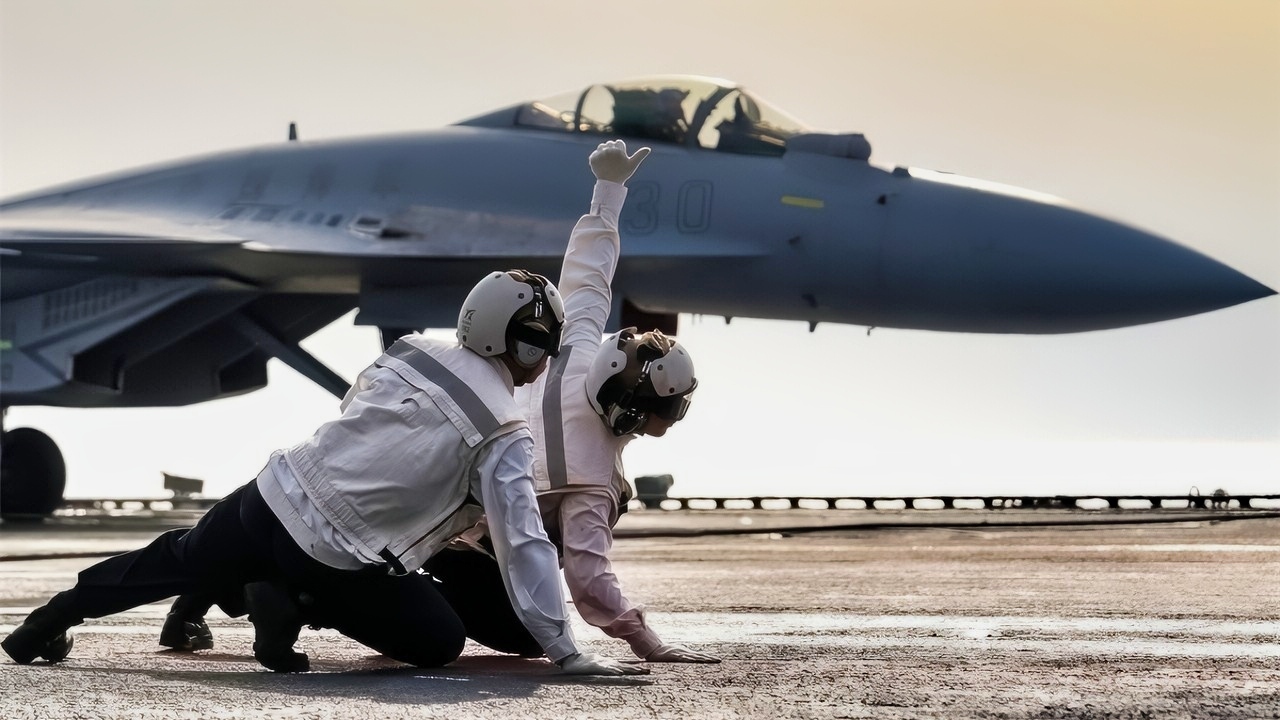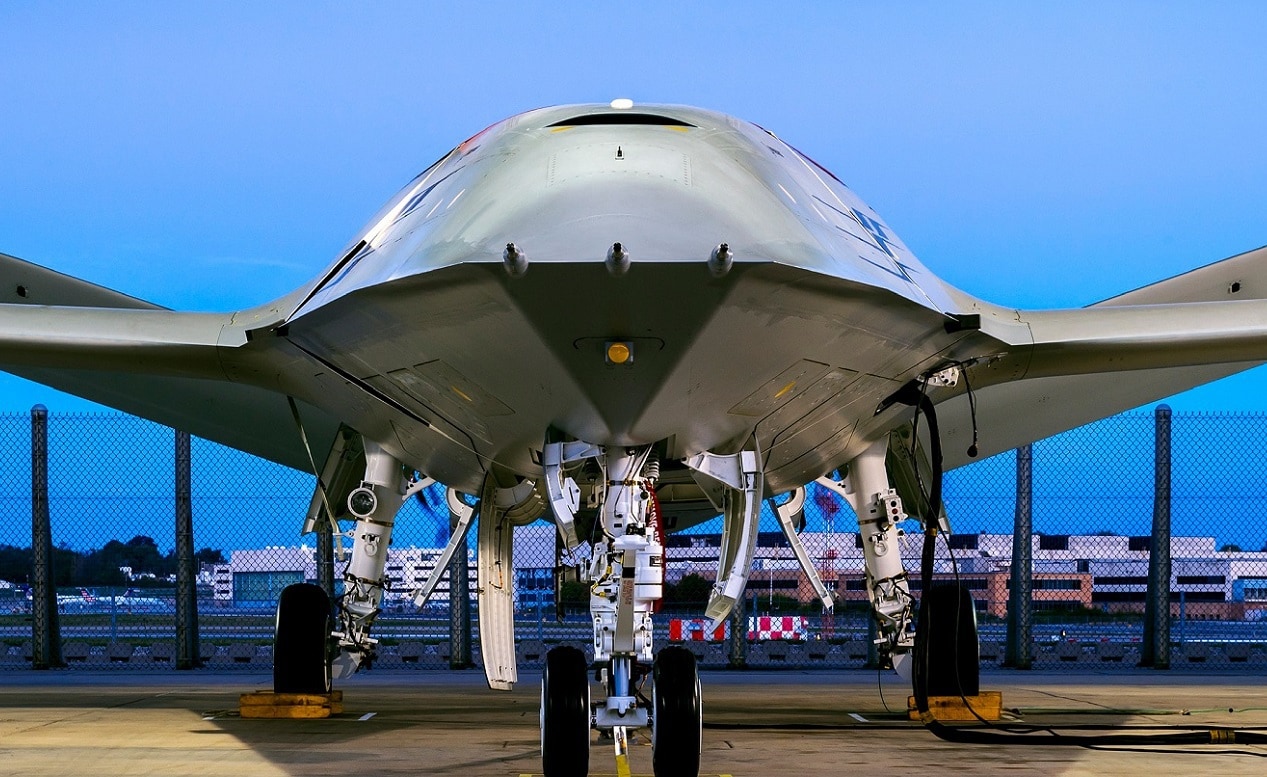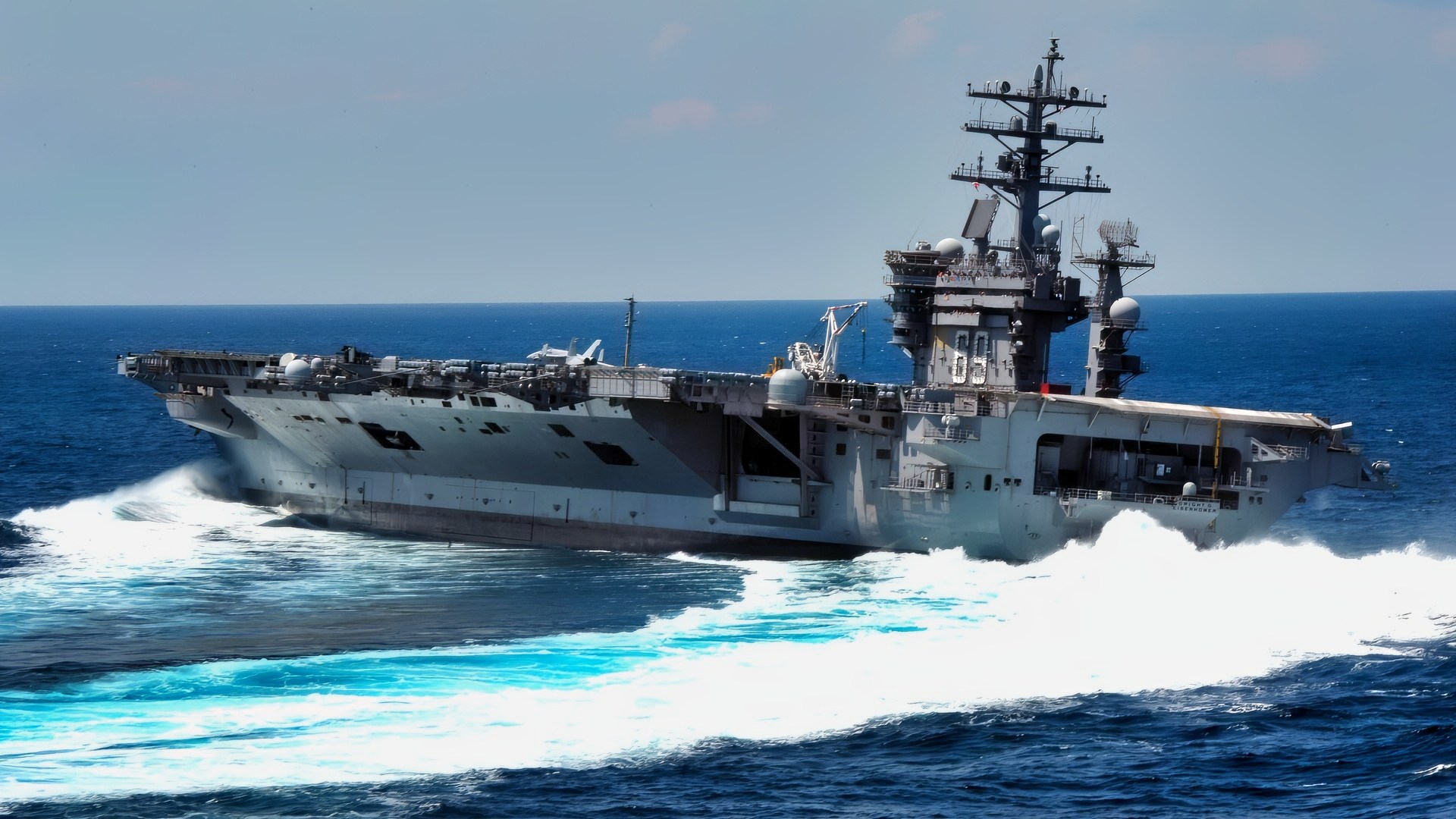Key Points and Summary – China’s new aircraft carriers, including the catapult-equipped Fujian, will complicate Western sea control, but they are not untouchable.
-The U.S. approach is a three-step kill chain: find, fix, finish.

China Aircraft Carrier in Port. Image Credit: Chinese Navy.

China Aircraft Carrier Operations. Image Credit: Chinese Navy.
-Space-based sensors, MQ-4C Triton drones, P-8A patrol planes, submarines, and allied inputs build the maritime picture.
-E-2D Hawkeye networks and electronic warfare hold the target long enough for standoff shooters to work.
-The “finish” comes from a layered mix: submarine-launched Mk 48 torpedoes, LRASM and Maritime Strike Tomahawk salvos from bombers, ships, and carrier jets, plus decoys, jammers, and precision sea mines.
-It’s not one weapon; it’s a multi-domain system designed to deter—and, if needed, sink—carriers.
Find, Fix, Finish: How To Sink China’s Aircraft Carriers in a War
China’s carriers are no longer theoretical.
Liaoning and Shandong have been busy training decks for years, and the big, catapult-equipped Fujian just flung a stealth jet and an airborne early-warning plane off its bow in sea trials—clear signals that Beijing wants blue-water reach. That begs a blunt question: if a shooting war ever came, how would the United States actually sink a Chinese carrier?
The honest answer isn’t a single wonder weapon or a movie-poster “carrier killer.” It’s a chain of actions that sounds deceptively simple: find, fix, finish.
Do those three things against a defended, mobile target in the world’s most surveilled seas, and the rest is mechanics. Miss any one of the three, and you’re throwing darts in a hurricane.

Pacific Ocean, July 25, 2005 – USS Ronald Reagan (CVN 76) performs a high speed run during operations in the Pacifc Ocean. Ronald Reagan and Carrier Air Wing One Four (CVW-14) are currently underway conducting Tailored Ships Training Availability (TSTA). Official US Navy Photo by Photographers Mate 1st Class James Thierry. (RELEASED)
Below is how that chain would likely work—and why it’s credible.
Why “Find, Fix, Finish” Matters
A carrier task group is designed to be hard to locate, harder to track, and hardest of all to hit.
The group can change speed and course, spoof its signature with electromagnetic tricks, and put up a thicket of defenses. That’s why the U.S. approach isn’t about one platform or one service “winning the day.” It’s about a kill chain that fuses space, air, sea, undersea, and cyber to keep custody of the target long enough to take it down.
Think of it like a relay race where the baton is target quality—handed from sensor to sensor until weapons get the last, clean look.
Find: Building The Maritime Picture
Satellites and high-altitude drones start the hunt. Overhead sensors can catch big deck movements, wake patterns, refueling tracks, and radar emissions that betray a task group’s position. Long-endurance Navy drones like MQ-4C Triton can loiter for a day at a time above 50,000 feet, sweeping huge swaths of ocean with a 360-degree active radar to spot and classify surface contacts far beyond a manned aircraft’s endurance. Triton’s job is less “sniper” and more “lighthouse”—constantly refreshing the big picture for everyone else.
Patrol planes such as the P-8A Poseidon layer in the closer look—sonobuoys for submarines, surface-search radar for ships, and the ability to snap an image, classify a vessel, and move on. The beauty of P-8s is their versatility: they can hunt subs at breakfast and feed targeting updates on a cruiser or carrier by lunch. As new weapons integrate with Poseidon, it becomes both a scout and, if needed, a shooter.
Allies add eyes. Japan, Australia, and others in the region run their own aircraft and ground-based sensors, contributing tracks that thicken the picture. The more independent lines of information you have, the harder it is for a carrier to slip the net with deception alone.
Undersea ears matter, too. U.S. attack submarines quietly collect acoustic cues and, at times, can shadow from standoff, providing the kind of persistent contact no satellite can. In the Pacific’s noisy waters, that’s an art form—and an American strength.
Fix: Pinning A Moving Target In Time
Finding is only half the job; you have to hold the target long enough to shoot from far away.
That means persistent updates and fast data sharing. Carrier-borne E-2D Hawkeye aircraft serve as flying quarterbacks, linking ships, aircraft, and missiles into a single fire-control web so that the best-placed shooter can take the shot with the freshest track. Networked sensors can cue long-range missiles to where the carrier is going, not where it was.
Fixing also means peeling away the fog. Electronic warfare and cyber tools can nudge adversary radars to reveal themselves, identify decoys, or force the task group to maneuver, which itself creates new tracks to exploit. And decoys like air-launched mini-vehicles can flood hostile screens with false “ghosts,” making it easier to separate the real carrier from its defenders once you know what to look for.
Finally, geometry helps. If submarines, ships, and aircraft come at different bearings, it’s harder for the carrier’s escorts to figure out which axis of attack to prioritize. Multi-axis pressure is what turns “fix” into “can’t-shake-it.”
Finish: The Many Ways To Kill Aircraft Carriers
When it’s time to shoot, the U.S. has a stack of arrows—each with a different flight path and defense problem for the target group:
From Below (Torpedoes). Nothing is more final than a heavyweight torpedo detonating under a ship’s keel. U.S. submarines carry the Mk 48 torpedo expressly for this job. It’s quiet, smart, and brutally effective against surface ships. If an American attack sub gets a clean shot inside torpedo range, the physics do the talking.
From Far Away (Cruise Missiles). The Navy and Air Force field LRASM—a stealthy, sea-skimming cruise missile designed to find and hit ships in the teeth of modern defenses. B-1B bombers can carry big salvos; carrier jets can launch from standoff; and integration across more platforms keeps expanding.
On the surface-ship side, the Maritime Strike Tomahawk (Block Va) adds an anti-ship seeker to a missile famous for land attack—now able to receive in-flight target updates and chase a moving warship hundreds of miles away. Even the Navy’s SM-6—originally an air-defense interceptor—has a proven anti-ship punch when the geometry is right, giving destroyers a fast, hard-hitting option to finish a damaged runner.
From Many Angles (Saturation And Deception). The trick isn’t just one “golden BB.” It’s volume and variety. A mixed raid—stealthy LRASMs from one direction, Tomahawks from another, and a submarine closing for torpedoes—forces a carrier’s escorts to defend everywhere at once. Throw in air-launched decoys and jammers that look like real threats on radar, and defenders waste interceptors and attention on ghosts while real missiles slip in.
From The Seabed Up (Smart Mining). In choke points and likely egress routes, the U.S. can seed precision-guided sea mines from long range. Modern “smart” mines can be delivered by heavy bombers well outside enemy air defenses, activating later to shape the battlespace—detouring a carrier into a predictable, lethal funnel.
Hit The Lifelines (Logistics And Sensors). No carrier fights alone. Kill or scare away the replenishment ships and land-based sensors that enable it, and its striking power withers fast. Strikes against shore-based over-the-horizon radars, long-range data relays, and tanker tracks don’t sink the carrier directly—but they strip it, making the final shot easier and less risky.
The Undersea Edge
If you’re looking for the quiet, odds-on favorite to land the decisive blow, it’s still the submarine. The U.S. Navy’s attack boats were built for this problem set: concealment, patience, and high-lethality ambush. With the Virginia-class adding a Virginia Payload Module (four large tubes that can carry dozens more cruise missiles), future subs bring both the stealth and the magazine depth to fight far from home waters and still punch hard. In a carrier-on-carrier duel, the sub is the piece that often doesn’t get a headline—but decides the outcome.
What About China’s Defenses for Aircraft Carriers?
China will not make this easy. Its carrier groups ride with large, modern escorts—the Type 055 and Type 052D—and can pull cover from long-range land-based aircraft and shore radars. Fujian’s electromagnetic catapults let Chinese jets launch heavier fuel and weapons loads, making their combat air patrols more persistent. All of this raises the bar the U.S. has to clear.
But defense has a math problem. Shipboard interceptors are precious and finite, and high-end missiles cost millions apiece. As one senior admiral bluntly warned recently, spending top-shelf interceptors to swat every incoming threat is unsustainable in a prolonged fight—especially if the attack mixes decoys, jammers, and multi-axis salvos. The U.S. play is to force that math on the defender.
The Air Wing Still Matters
This isn’t just a submarine story. A U.S. carrier air wing with F/A-18E/F and F-35C jets can stand off and lob LRASMs, while E-2D command-and-control aircraft glue the picture together. As the MQ-25 Stingray tanker arrives, Navy jets will push farther without leaning as hard on delicate tanker tracks, widening the arcs from which a mixed raid can be launched. Meanwhile, Air Force bombers—B-1Bs today, B-21s tomorrow—bring theater-spanning reach and big magazines to maritime strike, dramatically increasing the size and speed of salvos when the goal is to overwhelm defenses.

A MQ-25 Stingray sits parked in Hangar 1 on Scott Air Force Base, Illinois, May 12, 2023. The MQ-25 Stingray will be the world’s first operational, carrier-based unmanned aircraft and provide aerial refueling and intelligence, surveillance and reconnaissance (ISR) capabilities that enhance capability and versatility for the Carrier Air Wing (CVW) and Carrier Strike Group (CSG). (U.S. Air Force photo by Staff Sgt. Solomon Cook)

Image Credit: Creative Commons.
The Hard Parts We Don’t Talk About Enough
Finding first. The Pacific is huge. Carriers can sprint, hide in weather, and work EM-silent to complicate detection. Space and cyber contests will be fierce; expect both sides to take swings at the other’s eyes and ears.
Escalation management. Sinking a carrier is politically seismic. The U.S. would take pains to be right about attribution and proportionality, and to sequence attacks to deter further escalation, not provoke it.
Magazine depth. Long-range anti-ship missiles are not infinite. The United States is scaling production, but high-tempo naval combat burns through stockpiles quickly. Logistics—not tactics—may prove decisive in a fight that lasts more than days.
Deterrence, Not Wishful Thinking When it Comes to Aircraft Carriers
None of this is swagger. It’s about convincing Beijing that, for all the pride and investment in big decks, America has credible, layered ways to take them off the board. The exact playbook will evolve as new sensors arrive, new seekers go operational, and new platforms—like Block V Virginias and the B-21—enter the force. But the spine of the plan won’t change:
Find the aircraft carriers.
Fix its position through time.
Finish it with a multi-axis, many-weapon raid.
Do those three things, and you don’t just win a battle—you prevent one.
About the Author: Harry J. Kazianis
Harry J. Kazianis (@Grecianformula) is Editor-In-Chief and President of National Security Journal. He was the former Senior Director of National Security Affairs at the Center for the National Interest (CFTNI), a foreign policy think tank founded by Richard Nixon based in Washington, DC. Harry has over a decade of experience in think tanks and national security publishing. His ideas have been published in the NY Times, The Washington Post, The Wall Street Journal, CNN, and many other outlets worldwide. He has held positions at CSIS, the Heritage Foundation, the University of Nottingham, and several other institutions related to national security research and studies. He is the former Executive Editor of the National Interest and the Diplomat. He holds a Master’s degree focusing on international affairs from Harvard University.
More Military
The F-35 Has a Range Problem That Can’t Be Fixed
The F-14D Tomcat Still Haunts the U.S. Navy
The B-1B Lancer Bomber Almost Never Flew
Battleship USS Nevada Has a Message for the U.S. Navy
Forget Aircraft Carriers: ‘Light Aircraft Carriers’ Armed with Drones Might Be the Future










